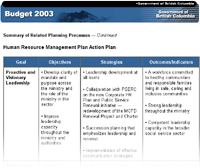 |
|
Summary of Related Planning ProcessesInformation Resource Management Plans (IRMPs)The ministry will plan and implement strategic technology solutions to improve the value of government information and services to citizens. This will be achieved through electronic service delivery, providing opportunities for citizen involvement, and technology tools supporting information sharing and program delivery. The ministry will form a strategic partnership with the governing authorities to develop technology solutions that support their mandates, as well as the mandates of the new ministry structure. The ministry will move towards an integrated client information and support system to support delivery of the right information to the right person(s) at the right time. This will include supporting performance management that will enable us to monitor the outcomes and effectiveness of our services. The systems will be designed to enable the ministry to successfully implement the mission and strategic shifts identified in the ministry's Service Plan. A number of e-Government initiatives have been started to transform the ministry from being closed, reactive and defensive to a culture that is open, accountable and transparent. These initiatives include making caseload data and planning information more available to the public; establishing and managing an electronic media room with the most up-to-date information about current ministry issues; exploring and developing online transaction capability in a number of areas; and providing technology tools that assist in streamlining related business processes. This will result in a reduction of workload and assist the ministry in meeting its budget targets. In addition, information will be made available electronically to demonstrate accountability. The ministry will also use the electronic services to promote citizen engagement and allow opportunities for them to be involved in planning and decision-making processes. The ministry will continue the review of legacy systems where possible, and work with other ministries to develop replacement options in the most cost effective and efficient manner. Human Resource Management Plan (HRMP)During the next year, the human resource objectives of the ministry will focus primarily on the strategic realignment of the ministry's organizational structure and human resources. In 2003/04, new service delivery models and reductions in the overall ministry budget will result in full-time equivalent (FTE) position reductions and devolution of specific services and resources, including staff, to community governance structures. Ministry initiatives require the Human Resource Management Plan (HRMP) to address workforce adjustment initiatives for some current employees. Activities will be related to leadership initiatives and the establishment of a new organizational structure to support government and ministry priorities. Strategies to support career planning and ongoing employee development will be an essential part of the ministry HRMP. The ministry is supporting the Corporate Human Resources Plan including public service renewal, responding to leadership challenges, and consolidation of human resource services into a more centralized and efficient delivery model. The HRMP continues to undergo change based on stakeholder feedback from the participants of the Leadership/Renewal forums. This expansion of the HRMP has in no way changed the goals, objectives, strategies and expected outcomes of the plan presented below. Vision of RenewalOver the next two years, the workforce of the ministry will be significantly diminished in total size. After services have devolved and employees have been transferred, the ministry will focus on:
DeregulationThe ministry continues to follow government's direction to determine
deregulation options that can result in service improvements. By
reducing "red tape" for ministry clients, front-line staff will
have more time available to assist clients rather than complete
unnecessary, onerous paperwork. In June 2001, the total number of the ministry's regulatory requirements (the baseline) was 16,963. For fiscal 2002/03, the ministry's target was 14,417 regulatory requirements. With results as of December 31, 2002 of 12,509 regulatory requirements, the ministry has met and exceeded its 2002/03 reduction target. Through ongoing identification of redundant and unnecessary regulatory requirements, the ministry expects to continue to meet regulatory reduction requirement targets for fiscal 2003/04 (11,874 regulatory requirements) and for fiscal 2004/05 (10,178 regulatory requirements).
|
||||||||||||||||||||||||||||||||||||||||||||||||||||||||||||||
|
|||||||||||||||||||||||||||||||||||||||||||||||||||||||||||||||


 The
ministry will continue to review its legislation, and related standards
and policies, to improve efficiency of service delivery through
a 40 per cent reduction of the ministry's regulatory requirements
by end of fiscal 2004/05.
The
ministry will continue to review its legislation, and related standards
and policies, to improve efficiency of service delivery through
a 40 per cent reduction of the ministry's regulatory requirements
by end of fiscal 2004/05.